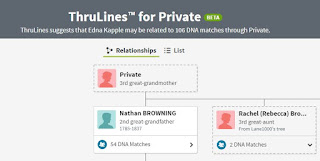Here are my impressions of the new tools:
Starting with the opt in tools. One allows you to color code your DNA matches, which may work for some people but I'm finding that too time consuming, and you have to remember the color code you're using for each family.
There are also new ways to filter matches as you can see in the snip below.
I did color code my brick wall Campbell family as you can see. You can create a custom group to filter by, or use filters that are already created.
Here are some additional filters:
I love the layout of the new match page. You can quickly see how many cm's a match shares, and there is a quick link to a page with your match's information. Another nice feature of the new match page is you can scroll down and see all of your matches without having to click to another page. This is a faster way to review more matches. Before I only checked the first couple of pages looking for new quality matches. Now I quickly see the number of cm's we share and scroll down to the point where I'm less confident about the matches. Knowing how many people are on a tree is great too. If there are only 2 people on a tree why bother.
One of my absolute favorite features is the ability to see notes for a match without clicking. This is a quick way to review matches. I have a standard way I note matches when I can identify the common ancestor. I note the father's surname/mother's maiden name and the child's name if I know it.
The ability to see notes is especially helpful when reviewing the all important shared matches. Below we see a network of shared ancestors. Not seeing any other lines this match could be related through I'm confident enough to include the match in the Forgey/Roller line (the preceding generation is Roller/Zirkle). Sometimes you find you share more than one line, and can't say which line your shared DNA comes from?
Another new favorite tool of mine at Ancestry is Thrulines which is designed to replace Ancestry's DNA Circles and Shared Ancestor Hints. I barely looked at the DNA Circles. I found them too time consuming to sort through. I enjoy working with the DNA results; but, I actually make more progress doing research in old documents so I need to be able to quickly review the DNA results. The new tools do make the process of reviewing matches faster.
If you watched Diahan Southard's excellent RootsTech presentation on "Connecting Your DNA Matches" you learned how to use the new Thrulines at Ancestry to find networks of matches. She recommended using your best matches to create DNA networks. As she said the Circles and Thrulines are an automated way to do that, but you can create your own networks by looking at matches you share with your best identified cousin matches.
Thrulines uses trees and DNA to show possible lines of descent from a match. It's just a suggested line of descent that you need to verify. Suggested ancestors not on your tree are called potential ancestors. Potential ancestors are like the old Shared Ancestor Hints. Here we see a potential line of descent which is incorrect. It suggests I'm a descendant of Richard Browning's first wife's, Mary's, father William Winkler (Richard Browning had a thing for Marys because his 2nd wife was also Mary maiden name Callahan). William had a daughter named Mary Winkler who was the first wife of Richard, when she died he married a neighbor named Mary Ann Callahan. This wrong connection created a number of wrong potential ancestors. The positive aspect of this is Thrulines allowed me to find this wrong connection quickly so I could move on.
My primary goal right now is to find the parents of Sarah Campbell who was born about 1810, likely in Tennessee. There are 8 Thrulines matches for Sarah Campbell's daughter Charlotte. Elizabeth is my ancestor and there are 9 matches who descend from her. I need to look at these matches and see if any shared matches might relate to the Campbell line of this family? Since my matches through Elizabeth share more common ancestors, and more recent ones, than through Charlotte, my matches through Charlotte are likely to be more helpful in creating a network of shared matches that might lead me to a solution to my Campbell brick wall.
Some potential ancestors are called private because they are linked to private trees. It's important to click on those because there are generally named ancestors linked to them. My mother has 106 private matches through private trees.
The only thing I would change about the new features would be to make it easier to get from the filtered matches back to all matches.
AncestryDNA would be the best DNA test without a doubt if they allowed opt in sharing of DNA segment data. They are adding some great features, but without segment data they fall short of being the absolute best. They are a good and important place to test, but don't have all of the best tools.








No comments:
Post a Comment